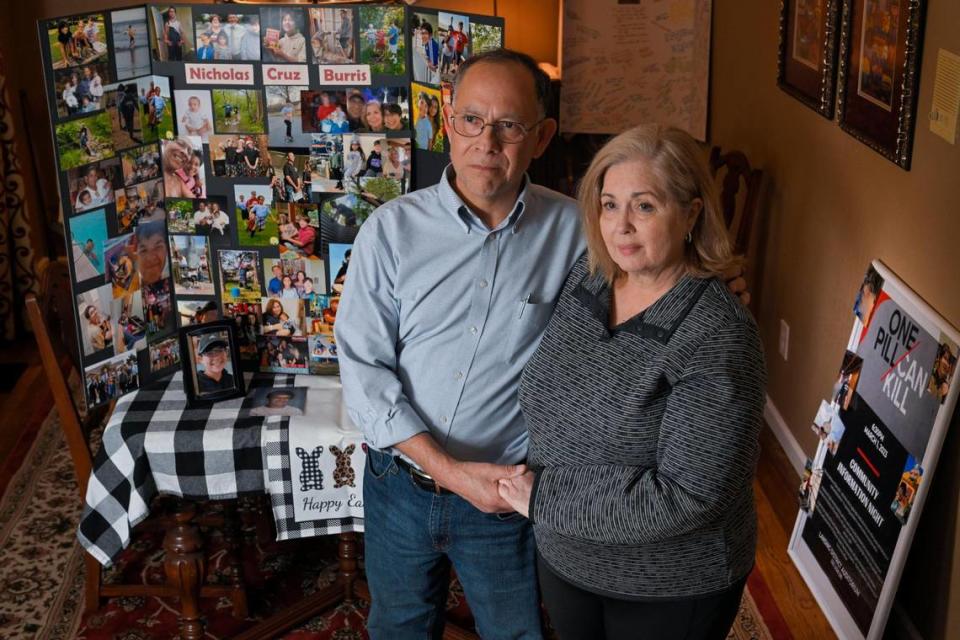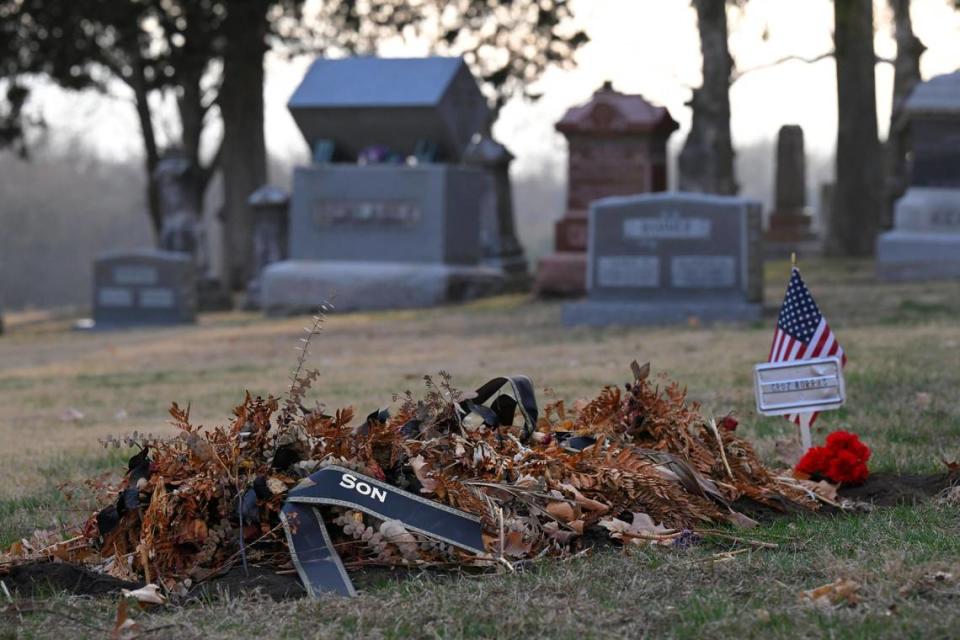‘Only takes one pill.’ Kansas high school freshman died from fentanyl-laced painkiller
Inside the Burris home, a guitar sits in its corner of the living room. A music stand holds sheets of music, where Nicholas Burris, called “Cruz” by his loved ones, would strum along to The Beatles, Queen and Chuck Berry.
Rhonda Burris will miss hearing her son’s fingers plucking, moving across the strings. The 15-year-old could pick up songs quickly and had even begun to write his own.
Cruz’s parents believe he could have gone far in his musical pursuits. Some days he dreamed of being an engineer for NASA, and other times he would say he wanted to become a contractor.
Either way, they said, Cruz was bound to do something great.
“There’s nothing Cruz couldn’t do,” his father, Andrew Burris, said.
Though he was a freshman at Lansing High School, students of all ages would greet him in the hallways — including the seniors. Cruz told his mother that was his favorite thing about school.
“‘People know me,’” she recalled him saying.
But the halls of Lansing High are a little more quiet now. The Burris home even more so.
On Jan. 18, Cruz swallowed a pill he bought through a dealer on Snapchat.
The dealer showed up to his house around midnight for the drop, handing over little blue pills he advertised on social media. Cruz FaceTimed his friends and told them he had just bought Percocet, unaware it was laced with fentanyl, a synthetic opioid 50 times stronger than heroin. Cruz died of an overdose.
His parents found him early the next morning.
Andrew Burris said he gave his son CPR while emergency medical services arrived, hoping something could still be done to save him, but he was already gone.
“That was the hardest I’ve ever, ever prayed,” he said.
Grieving the loss of their son, Cruz’s parents say they don’t want his death to be in vain. The Burris family hopes Cruz’s story will prevent others from buying pills off the street while alerting parents to the dangers of drug use.

Since Cruz’s death, the Burris family has been pushing for more education on the issue, organizing an assembly at their son’s school and connecting with a growing number of parents who have been through the same thing.
“I’ve met about a dozen parents who have the exact similar story that Rhonda and I share for Cruz,” he said.
Last year, the Kansas City Police Department announced that accidental overdoses from fentanyl had climbed nearly 150% from 2019 to 2020 in the metro area, particularly among ages 15 to 24.
A study from the Centers for Disease Control and Prevention released earlier this year showed that fentanyl-related overdose deaths rose 350% from 2019 to 2021 among American teens.
”If we can’t put a stop to it now, it’s gonna get worse,” Andrew Burris said.
‘Russian roulette’
Rhonda Burris said she had been getting on her son that school year about not smoking marijuana.
Conversations about the dangers of taking pills off the street were daily, and she had even warned him about fentanyl.
“I told Cruz over and over again … ‘You could die. You cannot do these drugs,’” she said.
But Andrew Burris said he thinks Cruz felt invincible, as do many kids his age.
Andrew Burris wants teens to understand the risk of overdosing is tangible, comparing buying pills from a dealer to playing with a loaded gun.
A game of “Russian roulette,” he said, where the pill-taker is unsure whether the drugs they’ve bought contain fentanyl.
“You just don’t know what these are laced with — these counterfeit drugs,” Andrew Burris said. “It only takes one pill to kill you.”

John Schrock, an assistant special agent in charge with the Drug Enforcement Administration, said it’s practically impossible to tell whether a pill contains fentanyl just by looking at it.
“If you didn’t get it from the pharmacy, it’s poison,” he said. “You’re taking a chance … you shouldn’t test it. You shouldn’t speculate.”
Schrock said fentanyl begins as a powdered form and can be mixed into other drugs or pressed into a pill form to look like less potent opioids such as Oxycodone. Fentanyl is cheaper and stronger than most other drugs of its class, and because it’s produced without proper care to ensure dosage is proportionate, the pills frequently contain fatal amounts.
Six out of 10 laced counterfeit pills contained a lethal dose of fentanyl, according to the DEA, which is just 2 milligrams. A photo on the agency’s website demonstrates that amount is just enough to fit on the tip of a pencil.
Last year, the DEA reported that law enforcement seized over 410 million lethal doses of fentanyl. So far this year, 47 million deadly doses have been seized.
A conversation ‘worth having’
On March 1, Andrew Burris stood on a stage in front of students and parents at Lansing High School for a presentation through the DEA’s One Pill Can Kill Campaign.
His message: This can happen to you.
Andrew and Rhonda Burris said they never thought they’d be telling the story of their son’s early death. But now that they know firsthand fentanyl is in their community, they feel compelled to raise the alarm.
“Instead of seeing my son graduate with a diploma in his hand, I have a death certificate in this hand,” Andrew Burris said.

Schrock said the DEA has been conducting ongoing education efforts in the community and schools, urging parents to discuss with their children the risks of taking pills that haven’t been prescribed to them.
“As it relates to parents, just having the conversation, as silly as it may seem as elementary or basic as it seems … I think is worth having,” he said.
He encourages those who suspect their child may be using drugs to keep the overdose reversal drug Naloxone, called Narcan when in a nasal spray form, at home. A map of pharmacies that distribute Narcan in Kansas is available on the Kansas Board of Pharmacy website.
Narcan is also available to Missouri residents at several pharmacies. Per a state standing order, a prescription is not needed to purchase Narcan in Missouri.
The assembly was one of many ways Andrew Burris hopes to prevent other parents from experiencing the same heartbreak he has. He says he’s been speaking with several elected officials and hopes to start a website dedicated to raising awareness in his son’s memory.

A GoFundMe set up by Cruz’s friends’ parents hopes to create a memorial scholarship in his honor.
Though grappling with the loss of their son, Cruz’s parents are dedicated to sharing his story.
Rhonda Burris said she believes her son would be happy if he knew he had saved someone else’s life.
“We say there’s a reason for everything,” Andrew Burris said. “God took our son to heaven for a reason. OK, what is this reason?
“Maybe the reason is to save another thousand children from his loss, and that’s something that I’d like to think may be true.”

 Yahoo Movies
Yahoo Movies 